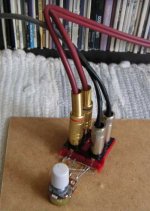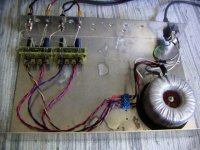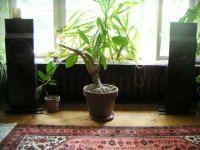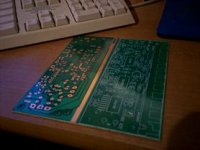ad hifi+:
This reviewers English is sometimes undecipherable to me: Did he just like it (sort of), or did he love it (better than Ayre)? Perhaps not. Or my admittedly restricted knowledge of English does not put me in the "state of understanding" this article fully - maybe I have to read it once more.
Anyway, it is a very positive review - may the orders be with you then.
Klaus
ps: - and the golden feet look kinky and "chinese" - here I have to agree sadly
This reviewers English is sometimes undecipherable to me: Did he just like it (sort of), or did he love it (better than Ayre)? Perhaps not. Or my admittedly restricted knowledge of English does not put me in the "state of understanding" this article fully - maybe I have to read it once more.
Anyway, it is a very positive review - may the orders be with you then.
Klaus
ps: - and the golden feet look kinky and "chinese" - here I have to agree sadly
Congratualtions on the great review Peter!
Klaus: I understand how you're confused as I am somewhat too. My interpretation is that the Amp-2 is more transparent and serves the music better than the Ayre but the Ayre wins out in it's so called calmness and more taught bass in the sense of a "Hi-Fi" presentation. Odd that he uses the word bodacious when the sentence "...slightly drier presentation that made the Ayre sound positively bodacious." Bodacious means remarkable or prodigious, it seems like he's contradicting himself.
I take the review as being very positive overall, and personally would overlook the comment regarding the Music First Passive because either preamp is crossing the pond from it's country of origin. The Music First from Britain will of course be cheaper to him as the Canadian based Pre-1 will be to us North Americans.
Klaus: I understand how you're confused as I am somewhat too. My interpretation is that the Amp-2 is more transparent and serves the music better than the Ayre but the Ayre wins out in it's so called calmness and more taught bass in the sense of a "Hi-Fi" presentation. Odd that he uses the word bodacious when the sentence "...slightly drier presentation that made the Ayre sound positively bodacious." Bodacious means remarkable or prodigious, it seems like he's contradicting himself.
I take the review as being very positive overall, and personally would overlook the comment regarding the Music First Passive because either preamp is crossing the pond from it's country of origin. The Music First from Britain will of course be cheaper to him as the Canadian based Pre-1 will be to us North Americans.
Time for a small review:
Puzzled by all those experiences (also mine, I must admit) with the need of "amp-driving-preamps" I made a small experiment.
First, I never really understood the need of a preamp together with a non-inverting really. To get some isolation from the source, ok, but if the source is nothing unknown there is no real difference between the input of the buffer or pre or the poweramp exept the fact that the amplifying feedback loop "is near". My NaimClones need the whole setup with pre and poweramp to sound at their best, but although the NaimClone pre is verx good itself, it never convinced me combined with a LM3875 Chipamp. And: There is always enough power by the sources themselves to drive the chipamps to absurd levels, so why use another possible harmful amplifying stage for nothing?
So I made a small "passive preamp" consisting of a very cheap chinese carbon 50k log pot, wired in the tradional way. I then connected my PD-DAC (very good, very musical, as most of you already know...) directly to this pot and then to my - still in an experimental aluminium frame mounted - premium amps. The transformer's values are 2 x 24V / 300VA, I use two secondaries splitted to the both channels with their own rectifiers (no hum at all, btw).
That sounds absolutely brilliant! Very transparent, almost unbelieveable clear, very musical and full. The "soundstage" is wide, and the bass is low and quite precise, not more slightly overblown than with other setups with these amps. The pot is not very linear especially turned down
So what can I say? If I must be convinced for the need of a preamp here - this will be a hard task. A transformer based stage I can possibly imagine - but this is too far out for to experiment with. If I was able to create such good sounding amps - say - 20 years earlier, this would have been a "small revolution". This humble setup tells me everything I need from the music and the recording, it reveals more information that I had expected.
This is how the bl**dy thing looks like:
Puzzled by all those experiences (also mine, I must admit) with the need of "amp-driving-preamps" I made a small experiment.
First, I never really understood the need of a preamp together with a non-inverting really. To get some isolation from the source, ok, but if the source is nothing unknown there is no real difference between the input of the buffer or pre or the poweramp exept the fact that the amplifying feedback loop "is near". My NaimClones need the whole setup with pre and poweramp to sound at their best, but although the NaimClone pre is verx good itself, it never convinced me combined with a LM3875 Chipamp. And: There is always enough power by the sources themselves to drive the chipamps to absurd levels, so why use another possible harmful amplifying stage for nothing?
So I made a small "passive preamp" consisting of a very cheap chinese carbon 50k log pot, wired in the tradional way. I then connected my PD-DAC (very good, very musical, as most of you already know...) directly to this pot and then to my - still in an experimental aluminium frame mounted - premium amps. The transformer's values are 2 x 24V / 300VA, I use two secondaries splitted to the both channels with their own rectifiers (no hum at all, btw).
That sounds absolutely brilliant! Very transparent, almost unbelieveable clear, very musical and full. The "soundstage" is wide, and the bass is low and quite precise, not more slightly overblown than with other setups with these amps. The pot is not very linear especially turned down
So what can I say? If I must be convinced for the need of a preamp here - this will be a hard task. A transformer based stage I can possibly imagine - but this is too far out for to experiment with. If I was able to create such good sounding amps - say - 20 years earlier, this would have been a "small revolution". This humble setup tells me everything I need from the music and the recording, it reveals more information that I had expected.
This is how the bl**dy thing looks like:
Attachments
Thank you, Adolphe, but you did not see my other chipamps yet. They are mostly much smaller... and even more minimal. One of the next projects - not fully ready yet - will incorporate smd resistors soldered to the chips directly.
But the PD PCBs are so brilliant (and shiny...) and Peter's choice of components is definitely the best I heard in this amps. No wonder that the Hifi+ review was good - I would have never read this mag again, if they would have rejected it
But the PD PCBs are so brilliant (and shiny...) and Peter's choice of components is definitely the best I heard in this amps. No wonder that the Hifi+ review was good - I would have never read this mag again, if they would have rejected it
That's how I also plan to implement my chipamp with the chip board mounted to the rectifier board, albeit I was only going to use a single rectifier board for the pair of chips.
How do you have that transformer wired up? Is a single pair of secodaries paralled at that terminal strip, then feeding each rect. board?
How do you have that transformer wired up? Is a single pair of secodaries paralled at that terminal strip, then feeding each rect. board?
Yes. I do not have good experiences - for what ever reasons - with common rectifiers for both channels. I once tried that, found the channel separation very poor, changed it and never tried it again since. I know this is contradictory to the general use and experience.
I used just two secondaries splitted to two full bridge rectifiers - like many amp producers I suppose. At least I know that practice from some Naim amps. And seperate transformers for each channel is probably better, but a 300VA torodial transformer should be enough for two amp channels. I have though very good experiences with full wave rectification (four diodes and four secondaries per channel!) but that cannot be called easy. (Please look at the webside by clicking the button below. This shows another chipamp with that configuration - with much cheaper parts than PD's but with a good sound nevertheless.)
To be honest: There is still a little hum (very little) with this "el cheapo" setup. But this can be cured by better screening (consider the passive pot with cables etc.) and a different grounding circuit. It is much better with the pot within the case of the amp of course to avoid the second pair of cable lenghth. This is the simplest configuration I would recommend. To create a high class "intergrated amp" with that setup is so incredible easy...
I used just two secondaries splitted to two full bridge rectifiers - like many amp producers I suppose. At least I know that practice from some Naim amps. And seperate transformers for each channel is probably better, but a 300VA torodial transformer should be enough for two amp channels. I have though very good experiences with full wave rectification (four diodes and four secondaries per channel!) but that cannot be called easy. (Please look at the webside by clicking the button below. This shows another chipamp with that configuration - with much cheaper parts than PD's but with a good sound nevertheless.)
To be honest: There is still a little hum (very little) with this "el cheapo" setup. But this can be cured by better screening (consider the passive pot with cables etc.) and a different grounding circuit. It is much better with the pot within the case of the amp of course to avoid the second pair of cable lenghth. This is the simplest configuration I would recommend. To create a high class "intergrated amp" with that setup is so incredible easy...
I should mention that PD uses Panasonic caps in the AudioZone Amp2, so this amp is - besides the case of course - similar to the Audiozone premium kits.
The review mentioned that the amp is internally hardwired: Peter, did you do that yourself (what a work!) and why no PCB?
The review mentioned that the amp is internally hardwired: Peter, did you do that yourself (what a work!) and why no PCB?
lohk said:This is how the bl**dy thing looks like:
That's what I added to my home made Patek. An Alps attenuator and an separate input selector. After reading the review in Hifi+ I still don't know whether the Pre Amp T1 would do a better job. Anyway, using transformers for this purpose was new to me and quite interesting. I found the review on 6moons.com of the UK product ... of Music First ...
http://www.6moons.com/audioreviews/musicfirst/passive.html
... and noticed all the wires on the photos and realised that a transformer consists mainly of wires and was wondering how this mixed with the Gainclone idea of using wiring as limited as possible. And how does it affect the sound? Anyway, I never listened to a pre-amp based on this principle and the review was not very clarifying.
In the meantime you will find quite a lot about transformer based attenuators or "pre-amps" somewhere at this forum. These will make a lot sense to me - but they have to be made with the maximum possible quality, that means they are pretty expensive. Please search the according threads.
Peter juses the only real good one availlable, I suppose.
But here we have the same old story: Does it justify the hefty price difference to a cheap (or maybe not so cheap) pot? I cannot tell, without having heard one.
Considered by the price of the components alone I would call the Pre-T1 a bit of a bargain - I could not make it like this. If I would have let made all those parts (machined, etc.) it will probably be much more expensive.
Peter juses the only real good one availlable, I suppose.
But here we have the same old story: Does it justify the hefty price difference to a cheap (or maybe not so cheap) pot? I cannot tell, without having heard one.
Considered by the price of the components alone I would call the Pre-T1 a bit of a bargain - I could not make it like this. If I would have let made all those parts (machined, etc.) it will probably be much more expensive.
Banned
Joined 2002
Id have to say that passive pre-amp is a really good choice. I bought the Bosoz Pre-amp and i'll switch back and forth between the bosoz & the passive pot and i always pick the passive pot. To me it sounds cleaner and better. Now to buy a better one and go from there. The only reason i use the bosoz at times is because it plays the speakers louder. 
The idea also was to use the sensible cheapest possible passive pre.
I am fully aware that passive "preamps" are not always the best possible choice, and in that topology the quality of parts is probably tricky then elsewhere. Cables and everything become exceedingly difficult. But if you consider impedance problems properly, it can obviously be done.
(I also remember from studio practice, that in "the older days" we used passive faders with transformers, but not like the S&B T102. The input transformer changed from 600Ohms to 10k, the followed a symmetrically wired potentiometer, then followed another output transformer from 10k back to 600Ohms.)
But this would be better off into any passive pre thread.
For chipamps in the trusted topology (so NOT with the inverted amps) I find just a pot at the input quite right. Gain is plenty: Did you really have "driving" problems? I did not have any, even with the passive output of the PD-DAC. (If you have driving problems check your sources: So do not drink and drive, btw )
)
I think that very loud signals with narrow frequency spectra can overdrive the amp easily (but this can be also a problem of the DAC driving cables and pots directly, so the next will be to try these amps (say the premium as a reference) with a simple tube or fet buffer). Maybe I will find - as an experiment, do not get me wrong - another "el cheapo" solution.
I am fully aware that passive "preamps" are not always the best possible choice, and in that topology the quality of parts is probably tricky then elsewhere. Cables and everything become exceedingly difficult. But if you consider impedance problems properly, it can obviously be done.
(I also remember from studio practice, that in "the older days" we used passive faders with transformers, but not like the S&B T102. The input transformer changed from 600Ohms to 10k, the followed a symmetrically wired potentiometer, then followed another output transformer from 10k back to 600Ohms.)
But this would be better off into any passive pre thread.
For chipamps in the trusted topology (so NOT with the inverted amps) I find just a pot at the input quite right. Gain is plenty: Did you really have "driving" problems? I did not have any, even with the passive output of the PD-DAC. (If you have driving problems check your sources: So do not drink and drive, btw
I think that very loud signals with narrow frequency spectra can overdrive the amp easily (but this can be also a problem of the DAC driving cables and pots directly, so the next will be to try these amps (say the premium as a reference) with a simple tube or fet buffer). Maybe I will find - as an experiment, do not get me wrong - another "el cheapo" solution.
Banned
Joined 2002
I've used my passive pre-amp on gain clones AND aleph amplifiers IN se mode. Never had a problem. Only ran into a problem when i went to use the DAC i have it has a tube buffer witch causes problems for impedance. That has been my only struggle. So far i've been using my sony cd player and my alephs and passive pot and have been switching between the sony cd player and my cheap dvd player and my dac.
Id have to say i like my bozos but i don't like the noise it brings.
Id have to say i like my bozos but i don't like the noise it brings.
So, if the signal level permits, it is mostly an impedance problem, with some separation problems too. Once I tried a Creek4040 integrated (quite good sounding amp from the 80s) as a power amp with a Naim preamp. The difference between passive and "active" was breathtaking. So it is not so easy and has to be tried. But with chipamps it works, and also with alephs, good to hear.
klaus
ps: Karma, can you explain what you mean?
klaus
ps: Karma, can you explain what you mean?
does anyone have a link where i can pick up the transformers used in the audiozone T1? in canada.
http://www.6moons.com/audioreviews/audiozone4/pretone.html
thank you.
http://www.6moons.com/audioreviews/audiozone4/pretone.html
thank you.
Attachments
This discussion brought me to the idea to make a new input in my integrated Gainclone with Alps so I can use it as a power amp as well and try a pre-amp in my system when I want to. Can I just wire the extra input 'behind' the Alps and use it when needed or do I need to buy a switch as well to separate the circuits when I want to be able to switch between integrated or power amp?
Actually my Sheng Ya CD-S10 player has a volume setting as well so normally I could connect the CD player to this new input and pass the Alps at the amp completely ...
Actually my Sheng Ya CD-S10 player has a volume setting as well so normally I could connect the CD player to this new input and pass the Alps at the amp completely ...
karma said:does anyone have a link where i can pick up the transformers used in the audiozone T1? in canada.
bentaudio.com (in BC) is North American distributor for Stevens & Billington transformers.
- Status
- This old topic is closed. If you want to reopen this topic, contact a moderator using the "Report Post" button.
- Home
- More Vendors...
- Audio Sector
- AudioSector-chip amp kits, dacs, chassis



